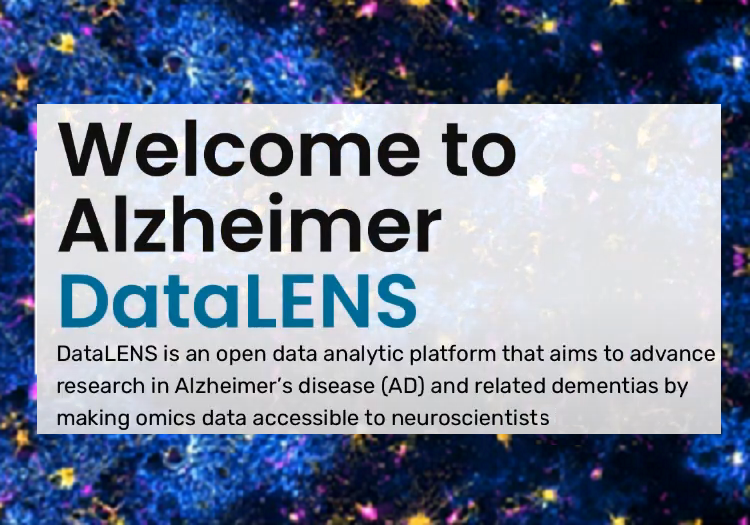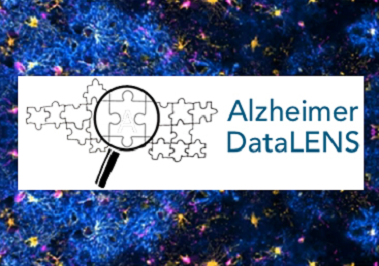
New portal accommodates more complex data
The current version of the Alzheimer DataLENS portal was designed for bulk omics data and couldn’t be readily adapted for the higher volume and more complex single-cell data. Thus, over the past few months, with support from IOS Press, we have developed the next-generation portal of omics data: DataLENS 2.0. To this new version of the site we have added several public snRNA-Seq datasets, and users will be able to compare expression across cell types and brain regions for their gene of interest. Users can also investigate gene expression or cell-type proportion changes with Alzheimer’s disease pathology across various cell types and brain regions. All visualization is interactive and available either at the individual cell level or at the sample level. In Alzheimer DataLENS 2.0, users can resize, zoom, format, and download images for their publication.
In addition to single-nucleus RNA-Seq data, we also ported bulk gene expression studies from five different brain regions as well as an atlas of astrocyte immunohistochemistry studies. DataLENS 2.0 is developed on a new software platform, R Shiny, that is scalable, flexible, and allows ready development of interactive websites. The website is hosted on an Amazon Web Services (AWS) cloud computing platform, and the software and tools will be openly accessible to all bioinformatics researchers and software developers. We aim to make DataLENS 2.0 available to the Alzheimer’s research community by the end of 2022.
There are future plans to apply this software to other areas of research.
References
- H. Mathys, J. Davila-Velderrain, Z. Peng, F. Gao, S. Mohammadi, J.Z. Young, M. Menon, L. He, F. Abdurrob, X. Jiang, A.J. Martorell, R.M. Ransohoff, B.P. Hafler, D.A. Bennett, M. Kellis, and L..H. Tsai, “Single-cell transcriptomic analysis of Alzheimer’s disease,” Nature, 570, 332–337 (2019).
- A. Grubman, G. Chew, J.F. Ouyang, G. Sun, X.Y. Choo, G. McLean, R.K. Simmons, S. Buckberry, D.B. Vargas-Landin, D. Poppe, J. Pflueger, R. Lister, O.J.L Rackham, E. Petretto, and J.M. Polo, “A single-cell atlas of entorhinal cortex from individuals with Alzheimer’s disease reveals cell-type-specific gene expression regulation,” Nature Neuroscience, 22, 2087–2097 (2019).
- S.F. Lau, H. Cao, A.K.Y. Fu, and N.Y. Ip, “Single-nucleus transcriptome analysis reveals dysregulation of angiogenic endothelial cells and neuroprotective glia in Alzheimer’s disease,” Proceedings of the National Academy of Sciences, 117, 25800–25809 (2020).
- K. Leng, E. Li, R. Eser, A. Piergies, R. Sit, M. Tan, N. Neff, S.H. Li, R.D. Rodriguez, C.K. Suemoto, R.E.P. Leite, A.J. Ehrenberg, C.A. Pasqualucci, W.W. Seeley, S. Spina, H. Heinsen, L.T. Grinberg, and M. Kampmann, “Molecular characterization of selectively vulnerable neurons in Alzheimer’s disease,” Nature Neuroscience, 24, 276–287 (2021).
- A.C. Yang, R.T. Vest, F. Kern, D.P. Lee, M. Agam, C.A. Maat, P.M. Losada, M.B. Chen, N. Schaum, N. Khoury, A. Toland, K. Calcuttawala, H. Shin, R. Pálovics, A. Shin, E.Y. Wang, J. Luo, D. Gate, W.J. Schulz-Schaeffer, P. Chu, J.A. Siegenthaler, M.W. McNerney, A. Keller, and T. Wyss-Coray, “A human brain vascular atlas reveals diverse mediators of Alzheimer’s risk,” Nature, 603, 885–892 (2022).
- E. Gerrits, N. Brouwer, S.M. Kooistra, M.E. Woodbury, Y. Vermeiren, M. Lambourne, J. Mulder, M. Kummer, T. Möller, K. Biber, W.F.Ad. Dunnen, P.P. de Deyn, B.J.L, Eggen, and E.W.G.M. Boddeke, “Distinct amyloid-β and tau-associated microglia profiles in Alzheimer's disease,” Acta Neuropathologica, 141, 681–696 (2021).
- F.J. Garcia, N. Sun, H. Lee, B. Godlewski, K. Galani, J. Mantero, D.A. Bennett, M. Sahin, M. Kellis, and M. Heiman, Neuroscience (2021).
- A.M. Smith, K. Davey, S. Tsartsalis, C. Khozoie, N. Fancy, S.S. Tang, E. Liaptsi, M. Weinert, A. McGarry, R.C.J. Muirhead, S. Gentleman, D.R. Owen, and P.M. Matthews, “Diverse human astrocyte and microglial transcriptional responses to Alzheimer’s pathology,” Acta Neuropathologica, 143, 75–91 (2022) (2021).
- Y. Zhou, W.M. Song, P.S. Andhey, A. Swain, T. Levy, K.R. Miller, P.L. Poliani, M. Cominelli, S. Grover, S. Gilfillan, M. Cella, T.K. Ulland, K. Zaitsev, A. Miyashita, T. Ikeuchi, M. Sainouchi, A. Kakita, D.A. Bennett, J.A. Schneider, M.R. Nichols, S.A. Beausoleil, J.D. Ulrich, D.M. Holtzman, M.N. Artyomov, and M. Colonna, “Human and mouse single-nucleus transcriptomics reveal TREM2-dependent and TREM2-independent cellular responses in Alzheimer’s disease,” Nature Medicine, 26, 131–142 (2020).
- M.B. Miller, A.Y. Huang, J. Kim, Z. Zhou, S.L. Kirkham, E.A. Maury, J.S. Ziegenfuss, H.C. Reed, J.E. Neil, L. Rento, S.C. Ryu, C.C. Ma, L.J. Luquette, H.M. Ames, D.H. Oakley, M.P. Frosch, B.T. Hyman, M.A. Lodato E.A. Lee, and C.A. Walsh, “Somatic genomic changes in single Alzheimer's disease neurons,” Nature, 604, 714–722.
- M.R. Corces, A. Shcherbina, S. Kundu, M.J. Gloudemans, L. Fresard, J.M. Granja, B.H. Louie, T. Eulalio, S. Shams, S.T. Bagdatli, M.R. Mumbach, B. Liu, K.S. Montine, W.J. Greenleaf, A. Kundaje, S.B. Montgomery, H.Y. Chang, and T.J. Montine, “Single-cell epigenomic analyses implicate candidate causal variants at inherited risk loci for Alzheimer's and Parkinson's diseases,” Nat Genet, 52, 1158–1168 (2020).
- A. Nott, I.R. Holtman, N.G. Coufal, J.C.M. Schlachetzki, M. Yu, R. Hu, C.Z. Han, M. Pena, J. Xiao, Y. Wu, Z. Keulen, M.P. Pasillas, C. O'Connor, C.K. Nickl, S.T. Schafer, Z. Shen, R.A. Rissman, J.B. Brewer, D. Gosselin, D.D. Gonda, M.L. Levy, M.G. Rosenfeld, G. McVicker, F.H. Gage, B. Ren, and C.K. Glass, “Brain cell type-specific enhancer-promoter interactome maps and disease-risk association,” Science, 366, 1134–1139 (2019).
- W.T. Chen, A. Lu, K. Craessaerts, B. Pavie, C. Sala Frigerio, N. Corthout, X. Qian, J. Lalakova, M. Kuhnemund, I. Voytyuk, L. Wolfs, R. Mancuso, E. Salta, S. Balusu, A. Snellinx, S. Munck, A. Jurek, J. Fernandez Navarro, T.C. Saido, I. Huitinga, J. Lundeberg, M. Fiers, and B. de Strooper, “Spatial Transcriptomics and In Situ Sequencing to Study Alzheimer's Disease,” Cell, 182, 976–991.e919 (2020).


